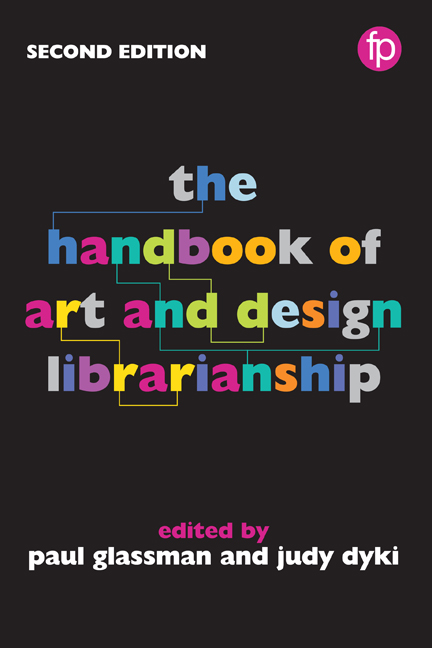Book contents
- Frontmatter
- Contents
- List of figures and tables
- Notes on contributors
- Foreword
- Preface
- Part I Roles and responsibilities
- Part II Materials and collection management
- 6 Visual resources: from analogue to digital and beyond
- 7 Developing digital collections
- 8 Inspirational encounters: the management and use of archives and special collections in the art and design library
- 9 What is special about special collections?
- 10 Artists’ books in the art and design library
- 11 Art documentation: exhibition catalogues and beyond
- 12 Tactile libraries: material collections in art, architecture and design
- 13 Seeing the bigger picture: archival description of visual information
- Part III Teaching and learning
- Part IV Knowledge creation
- Part V The physical environment
- Part VI Promotion and sustainability
- Appendix Library profiles
- Index
6 - Visual resources: from analogue to digital and beyond
from Part II - Materials and collection management
Published online by Cambridge University Press: 08 June 2018
- Frontmatter
- Contents
- List of figures and tables
- Notes on contributors
- Foreword
- Preface
- Part I Roles and responsibilities
- Part II Materials and collection management
- 6 Visual resources: from analogue to digital and beyond
- 7 Developing digital collections
- 8 Inspirational encounters: the management and use of archives and special collections in the art and design library
- 9 What is special about special collections?
- 10 Artists’ books in the art and design library
- 11 Art documentation: exhibition catalogues and beyond
- 12 Tactile libraries: material collections in art, architecture and design
- 13 Seeing the bigger picture: archival description of visual information
- Part III Teaching and learning
- Part IV Knowledge creation
- Part V The physical environment
- Part VI Promotion and sustainability
- Appendix Library profiles
- Index
Summary
Introduction
In a professional context, visual resources refers to the line of work that encompasses creating and managing collections of visual content. Working primarily with images, but also with video, virtual reality and other new media, visual resources professionals are involved heavily in digitization, cataloguing and preservation of these materials. In general, visual resources departments are found in academic institutions and museums, but they also exist in public and private libraries and archives. Some businesses may have visual resources units, often operating under a different name, such as digital asset management.
The study of art history relies heavily on image technologies (Kohl, 2012). Interaction with visual materials has also risen dramatically in the internet age. By staying on the cutting edge of technology, visual resource professionals can continue to provide targeted, meaningful advice to their patrons on finding, creating and using images effectively and ethically.
What are visual resources centres?
In the past, visual resources centres existed as slide libraries. Developments of photog - raphy and magic lantern slides in the 19th century enabled the study of art history as the discipline known today; without reproducible images, the study of art was limited. Art history degree programmes developed alongside early slide libraries, which included glass lantern slides and printed image collections for study.
By the 1950s, the development of 35mm slides provided a vast improvement over large, clunky lantern slides. Magic lantern projectors were susceptible to fires, but 35mm projectors ran safely and efficiently. The 35mm slides provided rich colour and were more portable. Slide libraries were necessary to house collections of images for the teaching of art history – everything from cave paintings to modern art (Kohl, 2012).
Towards the end of the 20th century, as the use of digital images increased, slide libraries underwent an immense transition. Slides gradually fell out of favour and today are rarely used for teaching. Visual resources centres shifted their efforts from creating slides to digitizing them. This continues to be an ongoing effort for many visual resource offices, having had hundreds of thousands of analogue images in their collections.
- Type
- Chapter
- Information
- The Handbook of Art and Design Librarianship , pp. 53 - 62Publisher: FacetPrint publication year: 2017



